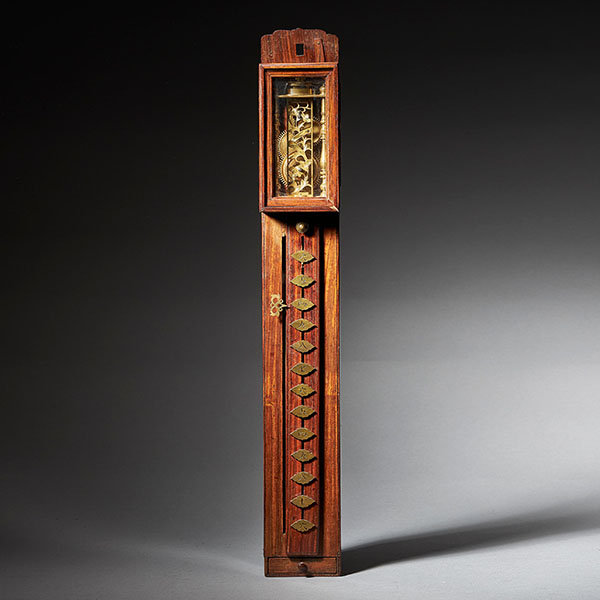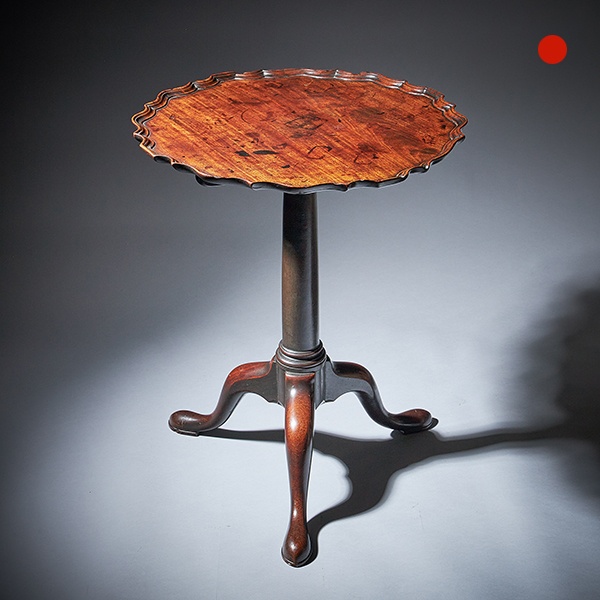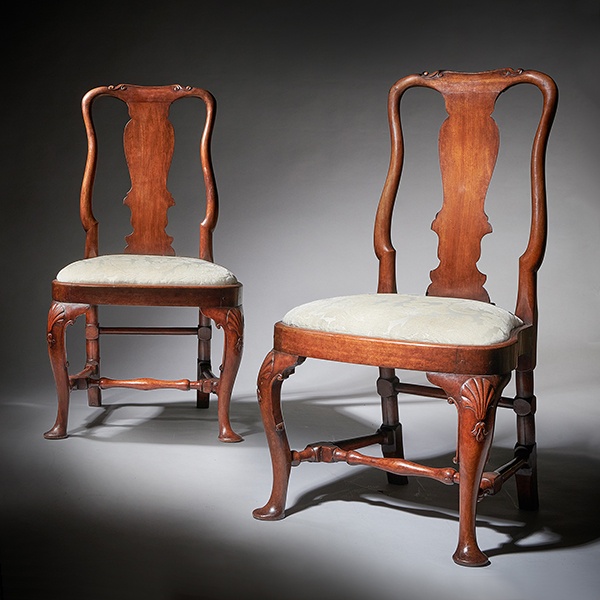Extremely Large William and Mary 17th Century Olive Oyster Cushion Mirror c.1690
Sold
Request Information
Follow Us
Extremely Large William and Mary 17th Century Olive Oyster Cushion Mirror c1690
An extremely large and rare William and Mary 17th century 41 inch olive oyster cushion framed mirror, circa 1690 England.
The age patinates mirror palte is bordered by a fine cross-grain ovolo moulding. The pulvinated frame is decorated entirely in well-chosen book-matched sections of olive oysters and edged with a beaded ovolo cross-grain moulding.
It should be noted that this is an extremely large example with a bold pulvinated frame that can only be described as stately.
The mirror is of a scale that would suit as an overmantel, console or above a large case piece.
Superb patinated surfaces.
Condition
Good. Wear consistent with age and use.
Dimensions
Height: 41.34 in. (105 cm)
Width: 32.68 in. (83 cm)
Depth: 2.96 in. (7.5 cm)
PREVIOUSLY SOLD
No Results Found
The page you requested could not be found. Try refining your search, or use the navigation above to locate the post.
No Results Found
The page you requested could not be found. Try refining your search, or use the navigation above to locate the post.
YOU MAY ALSO LIKE

Late Edo Period 19th Century Japanese Pillar Clock, Shaku-Dokei, C. 1820
Late Edo Period 19th Century Japanese Pillar Clock, Shaku-Dokei, C. 1820 £6,500Follow UsLate Edo Period 19th Century Japanese Pillar Clock, Shaku-Dokei, C. 1820 ELEGANT JAPANESE PILLAR CLOCK, 'SHAKU-DOKEI', c. 1820 The very fine 30-hour,...

George II Gun Barrel Mahogany Tripod Table, circa 1740-1750
George II Gun Barrel Mahogany Tripod Table, circa 1740-1750 SoldFollow UsGeorge II Gun Barrel Mahogany Tripod Table, circa 1740-1750 George II Gun Barrel Mahogany Tripod table. The well-figured top has a pie crust edge, resting on a gun...

18th Century George I Domed Topped Japanned Chinoiserie Falconry Box
18th Century George I Domed Topped Japanned Chinoiserie Falconry Box, circa 1710 £3,900Follow Us18th Century George I Domed Topped Japanned Chinoiserie Falconry Box, circa 1710 A rare and important Queen Anne - George I japanned chinoiserie...

Pair of George I 18th Century Carved Mahogany Chairs, Circa 1720
Pair of George I 18th Century Carved Mahogany Chairs, Circa 1720 £4,400Follow UsPair of George I 18th Century Carved Mahogany Chairs, Circa 1720 A superb pair of early 18th-century carved George I mahogany chairs, circa 1720. Each chair is of...

Pair of 18th Century George III Carved Mahogany Chippendale Chairs
Pair of 18th Century George III Carved Mahogany Chippendale Chairs £8,900Follow UsPair of 18th Century George III Carved Mahogany Chippendale Chairs A simply superb pair of carved George III mahogany chairs, C.1770. Condition Good. Wear...

18th Century Japanned Chinoiserie Dome-Topped Box, Circa 1715-1725
18th Century Japanned Chinoiserie Dome-Topped Box, Circa 1715-1725 £3,800Follow Us18th Century Japanned Chinoiserie Dome-Topped Box, Circa 1715-1725 Early 18th century George I Japanned Chinoiserie dome-topped box, Circa 1715-1725. England or...

Late Edo Period 19th Century Japanese Pillar Clock, Shaku-Dokei, C. 1820
Late Edo Period 19th Century Japanese Pillar Clock, Shaku-Dokei, C. 1820 £6,500Follow UsLate Edo Period 19th Century Japanese Pillar Clock, Shaku-Dokei, C. 1820 ELEGANT JAPANESE PILLAR CLOCK, 'SHAKU-DOKEI', c. 1820 The very fine 30-hour,...

George II Gun Barrel Mahogany Tripod Table, circa 1740-1750
George II Gun Barrel Mahogany Tripod Table, circa 1740-1750 SoldFollow UsGeorge II Gun Barrel Mahogany Tripod Table, circa 1740-1750 George II Gun Barrel Mahogany Tripod table. The well-figured top has a pie crust edge, resting on a gun...

18th Century George I Domed Topped Japanned Chinoiserie Falconry Box
18th Century George I Domed Topped Japanned Chinoiserie Falconry Box, circa 1710 £3,900Follow Us18th Century George I Domed Topped Japanned Chinoiserie Falconry Box, circa 1710 A rare and important Queen Anne - George I japanned chinoiserie...

Pair of George I 18th Century Carved Mahogany Chairs, Circa 1720
Pair of George I 18th Century Carved Mahogany Chairs, Circa 1720 £4,400Follow UsPair of George I 18th Century Carved Mahogany Chairs, Circa 1720 A superb pair of early 18th-century carved George I mahogany chairs, circa 1720. Each chair is of...

Pair of 18th Century George III Carved Mahogany Chippendale Chairs
Pair of 18th Century George III Carved Mahogany Chippendale Chairs £8,900Follow UsPair of 18th Century George III Carved Mahogany Chippendale Chairs A simply superb pair of carved George III mahogany chairs, C.1770. Condition Good. Wear...

18th Century Japanned Chinoiserie Dome-Topped Box, Circa 1715-1725
18th Century Japanned Chinoiserie Dome-Topped Box, Circa 1715-1725 £3,800Follow Us18th Century Japanned Chinoiserie Dome-Topped Box, Circa 1715-1725 Early 18th century George I Japanned Chinoiserie dome-topped box, Circa 1715-1725. England or...








